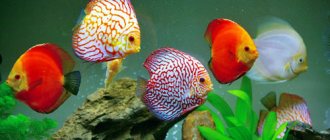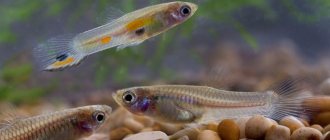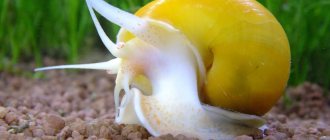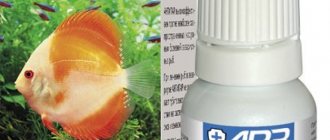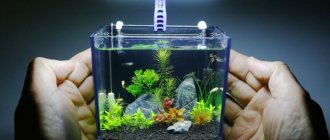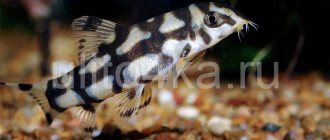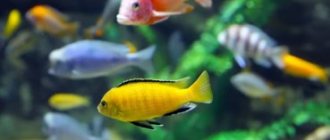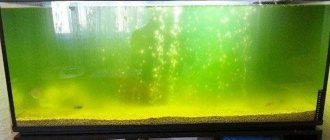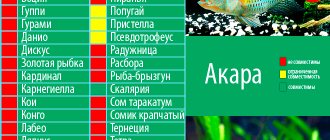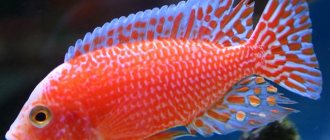Kinds
The cichlid family is divided into two groups:
- South American;
- African.
Differences appear in the conditions of detention and natural habitats. The former need soft water, the latter – medium and high hardness. Both groups have spectacular and colorful fish.
In the aquarium hobby, artificially bred and natural varieties are popular.
Apistograms
South American cichlids with a horizontal stripe running through the body of the fish. The trait is less pronounced in different species. Conventionally peaceful apistograms reach an average of 5–7 cm in length. Popular species: Ramirezi's Apistogramma, Cockatoo, Two-striped, Panda and Hongslo.
Astronotuses
Predatory fish Astronotus also come from Cichlids. Most 35cm water buffalos are raised in aquarium conditions.
Cichlazomas
Slender fish with a pointed muzzle. Body sizes range from 10–17 cm. Popular species: Cichlazoma Flamingo, Black-striped, Meeki, Festivum, Peaceful and Yellow. The color is spotted and striped.
Akary
Large representatives of cichlids. There are peaceful and overly aggressive fish. They have an interesting spotted color and pointed fins, for example, the turquoise acara.
Discus
The disc-shaped body shape and various colors with bright splashes make the fish special and recognizable. Graceful discus fish reach a length of 25 cm.
Angelfish
Along with discus, they are common majestic fish with a body of 15 cm. The leaf-shaped shape and long thread-like fins provide angelfish with attention and adoration.
Geophagus
Cichlids native to South America. They like to sift the soil in search of bottom microorganisms and plant particles. They reach 20 cm in length, have a massive body and a relatively large mouth.
Cichlids compatibility with other fish
Before getting fish of this breed, you should study the issue of Cichlid compatibility with other inhabitants of the aquarium. It is better to keep them separately, as they have a difficult character and can be aggressive.
Acara, Discus, and Angelfish have the most peaceful disposition. Cichlids get along well with Swordtails, Mellinesia, Gouramis, Danios, and catfish. These breeds live their own lives and do not offend other inhabitants of the aquarium.
African species
Most of the cichlids live on the African continent. The main habitats of these fish are some of the largest lakes in the world - Malawi, Tanganyika, Victoria, as well as other lesser known ones. In addition to lake species, there are also river species. The appearance of African cichlids is very diverse.
Most have an elongated, slightly flattened body. The fins of males are long, with sharp edges, while those of females are more rounded.
Some species have a growth on the head or a slightly elongated mouth.
Most species have spectacular, bright colors, which help to distinguish relatives from representatives of other species.
- Pelvikachromis pulcher or parrot cichlid has an elongated, slightly flattened body of yellow-brown color with a scarlet spot on the belly and small bright dots on the fins. In an excited state or during spawning, the color becomes more saturated. Parrots grow relatively small, males - about 10 cm, and females - up to 7 cm. The average life expectancy is approximately 5 years. It has a rather peaceful character.
- Hemichromis aureus is an inhabitant of ponds and rivers in western Africa. The body of the fish is elongated and flattened on the sides, the head has a high forehead and thick lips. The color is yellow-green, the belly is yellowish or faint red. There are 5 dark spots on the sides and gills. During spawning, the color of the fish becomes golden in color, and the abdomen becomes scarlet. On average they live up to 10 years, the maximum length becomes 15 cm.
- Hemichromis red is similar in description to the previous representative of cichlids, but differs in color. The fish has a bright red body with numerous bluish dots; they are even present on the fins. Males are slightly larger in size, and as they mature, they develop a growth on their head. Females have a lighter color and fewer spots. On average they grow up to 10 cm.
- Haplochromis cornflower is an inhabitant of Lake Malawi. It is distinguished by its unusual blue color. The lower fin of the fish is yellowish in color, the dorsal fin is different in length, and on it, like on the tail, there are several small yellow spots. Adults reach 20 cm, both males and females.
- Due to its rather scattered habitats, Haplochromis philander The largest representatives (about 11 cm) have a yellowish-green color with a golden tint, but the back and sides have a light blue tint, the body is covered with blurry stripes, turning into spots in the tail. Fish with smaller sizes (8 cm) are distinguished by a yellowish-olive color (males) and a clay-yellow color (females). The fins have small greenish dots, and the male has a bright red spot near the anal fin.
Males of the smallest representatives of the philander from Southeast Africa (up to 8 cm) have the same color as their medium-sized relatives, only with a pronounced blue tint; females are also similar.
- Frontosa is an inhabitant of the sandy bottom of Tanganyika. The body of the fish is long, with flattened sides and a high back; a characteristic growth appears on the head of adult individuals. The body color of the frontosa can vary from grayish-white to gray-blue; on the sides there are six transverse stripes of different widths of a dark tone. This type of fish is distinguished by its phlegmatic character and inactivity.
- Tropheus stellate is distinguished by a slightly elongated, arched body. The main color is black and blue, on the sides between the fins - the ventral and the beginning of the dorsal - there is a yellow, rather wide stripe located across. The fins are dark in color with black-blue edges and dots of a pale yellow hue. Can grow up to 12 cm.
- Pseudotropheus Pindani has an elongated body of a soft blue color, sometimes with a slight purple tint. The fins have dark blue rays. There are several yellow spots on the anal fin of males. Males are larger than females, but their colors are the same.
- Pseudotropheus zebra is distinguished by an elongated, slightly laterally compressed body and a fatty formation on the head. The species is characterized by an extraordinary color palette - about 50 color options: white, blue, red, yellow, orange. There are 7-9 transverse darker stripes on the sides.
- Pseudotropheus lombardo has a yellow-golden or yellow-brown color; in some cases, not very clear stripes are noticeable on the sides. The fins have a light blue tone, the anal fins are decorated with yellow dots, and the dorsal fins have a white edge. The fish reach 15 cm in length.
- Lamprologus are represented by several species, a characteristic feature common to all of them is an elongated body, but the colors are completely different. Lamprologus blue has an elongated body of a bluish tone with five black stripes across the sides; there is also a line of the same color on the forehead. Because of its color, it is also called the five-striped zebra. The length of males is about 15 cm, females have smaller parameters.
- Lamprologus ribbon shell can have several colors: blue, brown, yellowish or creamy orange; there are 9 thin silver stripes on the body.
- Lamprologus orange is distinguished by three color options: orange, golden yellow or blackish with numerous light spots.
- Lamprologus ocellata has a light brown body, on which 3 rows of shiny scales are placed in a longitudinal order.
- Labidochromis yellow, also called lemon or hummingbird, belongs to the dwarf species of cichlids. Individuals of both sexes have a yellow color; in the dominant males it is more saturated, and, in addition, their fins are black, with a yellow edging on the back. Females have yellow fins.
- The golden leopard has a flattened body and a high back. The main background is whitish-yellow, the whole body is covered with large spots of olive green and black stripes. The dorsal fin has a golden edge, and the caudal fin is yellowish-orange. When the male becomes sexually mature, his color changes completely, spots and stripes disappear, and his head and belly acquire a blue tint. The body becomes more yellow with slightly noticeable, blurred small spots.
- Melanochromis golden auratus has different color options for individuals of different sexes. Males have a brownish-black body and a golden back; on the sides there are 2 parallel blue horizontal stripes along the entire body. The fins are white-yellow or blue, with 1-2 light dots located on the anal fin.
The color of females is golden yellow with brown stripes. The yellow fins also have brownish lines, and the tail is decorated with black spots.
- The blue dolphin has a rather tall, slightly compacted body and a large head with a characteristic convex forehead (in adult males) and thick lips. Young representatives of the dolphin are characterized by a gray-blue color with a slight silvery sheen and dark stripes on the sides. In adult fish, the color of the fins and body is velvety blue. During spawning, the bulge on the male's forehead turns yellow.
- Aulonocara Benshi is characterized by a strongly flattened body of an elongated shape. The male’s forehead and body are yellow, but the mouth, cheeks and gills are purple, with 7-9 purple stripes located vertically on the sides. The female has a dark brown color with 8-9 dark stripes. Aulonocara grow up to 12 cm in length.
- The red kadango has a large head and mouth, with which it swallows large portions of water with plankton. In different parts of Lake Malawi, there are several varieties of kadango, which differ in color. Representatives of the Kadango with a bluish head and a yellowish or red body are popular as aquarium fish. Some fish have 3 black spots on both sides. Females are smaller and predominantly grayish in color.
- Maingano is also a dwarf cichlid species with an elongated body and a rounded head. There is a low fin along the entire back. The color of the fish is dark blue with two stripes located horizontally and having a blue color. The edges of the fins and tail are bordered by a thin bluish stripe.
How to distinguish a male from a female and their reproduction in an aquarium
Male Cichlids usually have more pronounced colors and are slightly larger than females, but there are breeds in which the females are larger.
With the onset of maturity, males develop a fatty growth on the head in most species, which does not occur in females. Males often have a dark spot on their sides. Pisces are very constant, choosing one partner for themselves.
Various species of Cichlids reproduce well in an aquarium if the proper conditions are maintained. It is better to place the pair in a separate container for the spawning period, provide dim lighting and the desired temperature depending on the species, and do not disturb the fish at this time.
Of all aquatic inhabitants, these fish are the most caring parents. Cichlids dig a hole in the sand or choose a place on a stone, on leaves in a secluded place, lay eggs, fertilize them and protect them from other inhabitants of the aquarium. By moving their fins, the parents create water circulation over the clutch. They remove dead eggs and monitor the condition of the eggs. A litter can reach 2,000 eggs, but not all survive.
African breeds tend to hold the eggs in their mouths to ensure the safety of their offspring. These breeds can have up to 100 eggs. During the ripening period of eggs, they refuse food.
The newly hatched fry stay in a school just below their parents or one of the parents, so the fry feel safe.
Asian cichlid species
There are only two naturally occurring species of cichlids thought to be found in the Asian region, but there are several others that overlap with the South American ones, such as the Oscars.
Spotted etroplus
Inhabitants of fresh and brackish waters of Sri Lanka and India.
Small fish, the maximum size of which rarely reaches 9 cm. Sexual dimorphism is weakly expressed, but males are slightly larger and brighter. They are quite peaceful and do not like to dig up the soil. Some aggression is shown during the period of caring for the fry.
The juveniles are very beautiful, the head is large with such large eyes that they seem to occupy its entire area. The main color is deep brown, and the chest is bright orange.
Green etroplus
Also common in water bodies of India and Sri Lanka, where they grow to almost half a meter in length.
In an aquarium, at 10-12 cm they already reach sexual maturity, growing to a maximum of 30 cm. They have a greenish color of scales and fins.
They are quite calm and peaceful, but they eat all aquatic plants.
Oscars
A very popular aquarium fish, which includes many subspecies with different fin shapes and scale colors.
They are found in nature in South and even North America, but an Asian species that lives in the reservoirs of Singapore is also known.
This is a fairly large fish, up to 35 cm long. The dark background color is colored with bright red spots. The high fins are black. This coloring is characteristic of natural species; breeding species are distinguished by a wide variety of colors.
After the Gulf War, many natural species of Asian cichlids were on the verge of extinction, so African tilapia are now introduced into reservoirs.
Multiple aquarium varieties of Asian cichlids have been bred based on natural isomorphs - Israeli Tilapia, Nile, Mango, Redberry, Ironocyclagordonsis, Green Chromide.
What to feed cichlids
It is important to feed this breed of fish correctly. First of all, you should study what type of food is suitable for a given species, carnivorous, herbivorous or omnivorous. You cannot feed Cichlids only with dry food; the fish need live food.
Herbivorous species happily eat chopped lettuce, spinach, and dandelion; they will not refuse vegetables: cucumber, zucchini, carrots.
Predators need live food, that is, protein food: live bloodworms, cortera, chopped squid, fish, grated beef heart or liver. Omnivorous species consume 30% protein foods, 70% plant foods.
What to feed the fry
The fry that have just emerged from the eggs are fed with ciliates, daphnia, sedge; when they grow up, they are fed with daphnia, live crushed bloodworms, and ready-made food.
Contents
To ensure living conditions and make life healthy and long, it is necessary to find out what living conditions are required for these creatures to get along. Availability of an aquarium with a capacity of more than 200 liters. Accurate adherence to temperature conditions; cichlid aquarium fish are extremely sensitive to temperature changes. The ideal temperature would be 27–28 degrees Celsius, and the water should be clean and enriched with oxygen. Availability of a filter and water aeration system for the aquarium.
Once a week the water is partially changed. Each species living in a common aquarium must have its own shelter, so it is necessary to zone the aquarium with plants, stones, and other decorative elements. As well as the presence of caves, houses and other places where they can make shelters for weak cichlids and spend time. The lighting of the aquarium should not be too bright; moderate diffused light is sufficient. You can purchase cichlidariums, these are special ready-made aquariums for keeping a certain type of fish based on the requirements for care and maintenance, which can easily get along. After all, each variety of cichlids in an aquarium may have distinctive care requirements. Therefore, before buying fish, it is better to consult a specialist.
Aquarium decoration
Many species of cichlids are big fans of digging up soil. Because of this, many aquarists decide to completely abandon vegetation in a glass home for underwater pets. But you can find another way out - place floating plants in it, which cichlids cannot harm . A normalized amount of duckweed will decorate the tank and make it more attractive.
Experts recommend giving preference to plants with hard leaves, strong stems and a strong root system. These criteria must first be met by those plants that you decide to place in the ground.
For some species of cichlids, such as discus, apistogramma and microgeophagus, vegetation in the aquarium is considered a prerequisite. Greenery serves as a good shelter for them and makes them feel completely safe.
The glass tank in which cichlids live should not be overloaded with a large number of objects. Tanks should be designed carefully, taking into account all the characteristics of the fish being described. Pisces definitely need space, a sufficient amount of free space where they can swim calmly.
If you do decide to plant vegetation in an aquarium with cichlids, then it is better to place it in small groups . Plants can be used to divide the internal space in the tank. They are often planted along the back wall.
The cichlid can be supplemented with beautiful artificial caves, grottoes, snags, and pipe cuttings. All these components should not be placed above the middle level in a glass container. It is advisable to place them away from each other.
Caves and grottoes can be made from flat stones or coarse pebbles. The ideal solution would be large sinks.
Compatibility
Typically, cichlid fish are aggressive only during the breeding season. At this time, they establish their territory, which is strictly prohibited for outsiders to enter. Naturally, the living area of the neighbors will be somewhat reduced, which can cause inconvenience for the entire population of the aquarium, so it is advisable to keep cichlids in spacious aquariums.
Note: It is not wise to keep several male parrot cichlids in one tank. The aquarium can be quite large and spacious, but only one male will take the lead and will chase the rest of the males and force them to hide in the thickets of plants.
Angelfish and parrots, as well as other calm and small cichlid fish, are well suited for living together: swordtails, mollies, platies, gourami, zebrafish, catfish, cockroaches, corydoras and other peaceful species with similar temperature preferences.
Feeding
The wide variety of conditions in which cichlids live has led to the fact that all types of food can be found in this group of fish. There are carnivorous, herbivorous and omnivorous species. Therefore, when choosing food, it is necessary to take into account the natural origin of fish and know their natural diet.
Cichlids can be called predatory and feed on small fish, zooplankton, mollusks and crustaceans. This group includes some African cichlids, cichlids, and American cichlids. Food for such fish must be rich in protein, otherwise growth and development may be delayed.
Malawian cichlids of the Mbuna group are typical vegetarians. Their diet should consist of 60-70% plant foods. In nature, these fish have adapted to scraping algae from the surface of rocks. In this they are helped by sharp teeth, which can also serve as a formidable weapon in skirmishes over feeding territory.
Despite the predominance of one type of food, not a single herbivorous fish will refuse to eat meat. This is necessary to compensate for the lack of essential amino acids in the body. Predators also need periodic feeding with plant foods as a source of vitamins.
Very often, owners start feeding cichlids, especially large predators, from the table: fish scraps, ground beef and even cat food. Unfortunately, this often leads to disastrous results. Firstly, the quality of the water in the aquarium may deteriorate. Secondly, fish do not always have the necessary enzymes to digest and assimilate proteins from an atypical diet (in nature, cichlids do not eat cows). Thirdly, a large amount of protein for herbivorous species will sooner or later lead to disruption of the gastrointestinal tract in fish. Finally, it is extremely difficult to balance such food with all nutrients and vitamins.
Thus, when feeding cichlids, it is best to pay attention to high-quality dry food, which is created taking into account the nutritional characteristics of the fish and is completely balanced. Tetra offers a wide range of food for different types of cichlids:
- Tetra Malawi (flakes and granules) is a high quality food with a special algae mixture ideal for feeding all herbivorous cichlids. Ideal for Malawian cichlids of the “Mbuna” group: golden melanochromis, pseudotropheus Sokolov (Pindani), haplochromis cornflower, aulonocar Nyasa, etc.
- For dwarf cichlids such as Apistogramma or Pelvicachromis, small granules such as Tetra Cichlid Mini Granules are a good choice. They fit perfectly into the small mouth of the fish.
- Tetra Cichlid Color is a floating food in the form of balls with a concentrate of natural color enhancers. Provides vibrant color to all types of red, yellow and orange cichlids. It will be indispensable for keeping hummingbird cichlids, aulonocaras, and golden leopards.
- Tetra Cichlid Sticks are the basic stick food for all cichlid species. Floating granules stay on the surface of the water for a long time and quickly saturate large fish such as astronotus or acara.
- Tetra Cichlid XL Flakes are the main food in the form of large flakes for all types of cichlids. The flakes remain floating on the surface for a long time and are good for fish that bite off pieces of food slowly, such as angelfish.
- Tetra Cichlid Pro is an innovative food in the form of chips, manufactured using gentle low-temperature technology, which allows you to preserve even more nutrients and vitamins. It will be a good help when feeding active medium-sized cichlids: princesses of Burundi, black-striped cichlids.
It is recommended to feed the fish several times a day with such a portion of food that they have time to eat in a few minutes. Do not overfeed the fish. It is useful for large cichlids to have “fasting days” once a week. The more varied the feeding of the fish, the better their health will be.
Behavior
It is the interesting behavior of these fish that has earned them such popularity among aquarists. For this, they are forgiven for all the difficulties of keeping that often arise in people who have not previously kept cichlids. By nature, cichlid aquarium fish are territorial. One individual or pair occupies a certain part of the aquarium and guards it. In large aquariums this does not create acute problems, other fish simply stay in the opposite part of the home pond, but in a small aquarium they have nowhere to go - and the matter can even end in the killing of a weaker individual.
What is typical for cichlids is that they often drive away only representatives of their own species, not paying attention to other fish. Only during the breeding season can aggression be directed at everyone. Even just watching fish swimming in an aquarium, you can notice their unusual behavior. In search of food, they can turn over objects, and some large species are even able to recognize their owner. This is clearly noticeable when feeding - they are ready to take food directly from his hands, while they will not take food from another person’s hands.
Health and life expectancy
Cichlids are fish that have a strong immune system. But this does not mean that they cannot get sick. If these underwater pets are kept incorrectly, they may end up contracting some disease. The causes of infectious, bacterial or chemical diseases can be:
- poor quality food;
- insufficient amount of feed consumed;
- water parameters that do not meet all requirements;
- fish poisoning with nitrates;
- stressful conditions.
Various infections can enter the aquarium as follows:
- with new vegetation, which is purchased either for design or for the general arrangement of the tank;
- through any type of soil;
- with live food;
- with new fish.
Cichlids most often suffer from such diseases.
- Hexamitosis. It manifests itself as enlarged pores in the head and lateral line. At the same time, the fish do not eat and suffer from exhaustion. This disease is treated only with metronidazole. If the stage is advanced, then the pets may die.
- Ichthyophthiriasis (“semolina”). If this disease occurs, a white coating appears on the body of the fish. It can only be treated with specialized means. The use of quinine hydrochloride is allowed.
- American Bloat . This disease manifests itself in the lethargy of the fish, as well as in their loss of appetite. The body of the individuals is inflated, the eyes bulge. This disease continues for 3 days, after which the fish die. Most often, American bloat occurs with people from Lake Malawi. The disease can only be treated with antibiotics.
- Saprolegniosis . With this disease, you can notice that growths similar to cotton wool have appeared on the body of the cichlids. This disease can only be treated with medications containing phenoxyethanol.
Many health problems for these underwater pets can be avoided if you provide them with proper care. It is important to monitor the condition of the fish in the aquarium, maintain optimal water parameters and provide only high-quality food. Only if these conditions are met can you expect cichlids to live a long time and not get sick.
The lifespan of different individuals is also different. In their natural habitat, cichlids can live 20-25 years, but in an aquarium their lifespan is significantly reduced. Rare individuals can live more than ten years. Of course, a lot depends on the conditions in which underwater pets live.
If you keep them correctly, they can live for a very long time without suffering from disease. If it is not possible to provide cichlids with proper care, they will not live a very long life.
Diseases
Cichlid fish are quite strong, but improper maintenance can lead to diseases. Even in a reasonably stocked aquarium with clean water and complete quarantine control, an outbreak of diseases cannot be avoided, the cause of which may be poor nutrition and non-compliance with the temperature regime (in this case, hypothermia).
The most common disease is ichthyophthyriosis (fish louse). Accompanied by compression of the fins and scratching of the fish on the ground. The body and fins are covered with a white coating in the form of small grains (semolina). The causative agent of the disease is an equiciliated ciliate parasitizing on the body of fish. Parasitic ciliates can be present in almost any aquarium, but they usually affect fish with a weak immune system.
Another common disease caused by improper fish keeping can be saprolegniosis. A fungus appears on the affected area, which resembles a stuck piece of cotton wool. All sick fish must urgently undergo treatment until complete recovery. You can learn how to cure sick fish from the publication “Treatment of aquarium fish with bicillin.”
How to distinguish a female from a male?
Many people are interested in how to distinguish a female cichlid from a male. If individuals of different sexes have pronounced distinctive features regarding body structure and color, then it will not be difficult to determine whether the animal in front of you is a female or a male. If the fish are monomorphic species, then a thorough examination will have to be carried out to determine their gender.
This should only be done with wet hands. You will need to carefully remove the fish from the aquarium and turn it belly up. This area of the pet's body will need to be carefully examined. Between the anal fin and the opening there is such a part as the genital papilla. It is through this hole that during the spawning period, females release eggs, and males release seed.
In females this hole is always large. When determining the sex of individuals in this way, certain difficulties may arise, especially if we are talking about species that lay eggs in the substrate.
In certain situations, differences in gender can be identified by paying attention to pigmentation, which occurs in the area of the genital opening. In males, the papilla usually protrudes slightly. If you run your finger over this area, this feature can be noticed.
Many aquarists often rely only on their size when determining the sex of fish. In most cases, male cichlids are larger than females and it is not difficult to understand their gender.
In addition, differences in fins can be seen in most species. In males they are pointed, and in females they are rounded.
Reproduction
Spawning in cichlids can occur at any time of the year, but it is preferable that it be spring or summer, since in ordinary reservoirs you can catch live dust or cyclops. If the eggs are removed from the producers, then spawning can occur with an interval of 15 days, and if the eggs and fry are left, the interval can reach two months.
Fertility varies considerably among each species of cichlid. For some, it can be 100 fry, since the parent carries the eggs and fry in the mouth, and for those who spawn on stone or plants, the number of offspring is measured in the thousands.
Most species are bred simply; it is enough to raise the water temperature to 26–32 degrees. The composition of the water does not matter for many fish, although some species require soft water. When choosing neighbors for your pets, you need to take into account not only who the cichlids live with, but also the temperature range, the size of the fish, their aggressiveness, and nutrition. Most cichlids spend their youth in schools. With the onset of puberty, they divide into pairs.
In a large aquarium with plenty of hiding places, cichlids will disappear into the corners and victims can be avoided. Malawian cichlids can be kept in schools if they are provided with some kind of reef. For Tanganyika tropheus, shelters are strictly contraindicated. And keeping small fish that live in schools together with most cichlids is simply impossible! Cichlids are, first of all, predators that feed on any fish smaller than themselves.
AKARA MARONI
ACARA BLUE-SPOTTED
Cichlids
The Cichlid family includes up to 3,000 species, which are distributed throughout the world. Almost half of them live in lakes and rivers of Africa, but colorful fish are also found in the warm rivers of South America and Asia.
They began to breed exotic pets in artificial reservoirs since the times of ancient Egypt, but in Russia and Europe they appeared only in the 20th century, they fell in love with lovers and breeders, who began to breed original and beautifully colored breeds, choosing the most peaceful species.
Cichlids in nature live in fresh or slightly salty lakes and rivers. They belong to the family of ray-tailed fish, the order of perciformes, and have sizes from 2.5 cm to a meter. The main part of Cichlids has a tall body, slightly flattened, with a large head. The commercial breed Tilapia belongs to the same family. The lifespan of fish reaches 10-15 years in an aquarium, in nature up to 20-25 years.
Table of basic parameters of maintenance, care and nutrition:
| What should be the volume of an aquarium for Cichlids? | from 150-300 liters |
| What should be the temperature in the aquarium for Cichlids? | from +20-28 °C |
| What pH should be in the aquarium? | from 6-8 pH |
| What should be the hardness of the water in the aquarium? | from 5-15° dH |
| What should be the substrate for an aquarium? | any |
| What kind of lighting should be in the aquarium? | moderate |
| What should be the movement of water in the aquarium? | moderate |
| Maximum fish size | from 2.5 cm to a meter (depending on the type) |
| What does aquarium fish eat? | depends on the type: aquarium plants; dry food; live food: daphnia, tubifex, bloodworms |
| Type of aquarium fish | aggressive |
| Who is compatible with in an aquarium? | get along with all non-aggressive fish species that do not fit in the mouth |
| Lifespan | up to 10-15 years |
Diseases: symptoms and treatment
With proper care and good feeding, Cichlids rarely get sick; they are naturally endowed with good health. Changes in living conditions and stressful situations can weaken their natural immunity and lead to illness. Hypothermia, the presence of chlorine, excessive water hardness, and poor nutrition have a negative impact on the health of fish.
Most often they suffer from ichthyophthoriosis, caused by a parasitic ciliate. At the same time, the fins can dry out and become deformed, the fish scratches itself on objects and becomes restless. The treatment is simple: place the fish in salted water (10 g per liter of water) for a few minutes, repeat if necessary. It is important to treat all the inhabitants of the aquarium and then refresh the water.
Sometimes the Saprolegniosis fungus appears, looking like a piece of cotton wool or a clot of foam. In this case, a course of treatment with bicellin is necessary.
Fish will remain healthy for many years if you care for them properly!
How to avoid diseases
When buying cichlid fish, you need to know what this species is. About preferences in: nutrition, compatibility with other fish, temperature, as well as water hardness and acidity. If you have a rare and expensive specimen, for example, discus fish that love perfectly clean water, then it is better to keep such fish in a separate aquarium.
As we already know, most diseases are directly related to the immune system, which in turn is influenced by quality nutrition. The conclusion is this: if cichlid fish do not receive live food for a long time, which actually contains the essential amino acids necessary for the body, the health of those fish that are fed at least occasionally with live food will be significantly lower.
Notes: it should be noted that we are not talking about free feeding here, but only about feeding. I feed my fish with Daphnia moina. I feed little by little: in the morning at lunch and in the evening. The benefits of such feeding are obvious: the fish never show signs of dystrophy, they quickly grow in height, are always vigorous and cheerful, and their fins are clean and straightened.
I use Daphnia moinea to feed fry and recently purchased fish that are still in quarantine. Live food acts like a calming pill on new fish. Daphnia relieves stress because hardly any fish can resist moina. You can order Daphnia moina for home breeding on the “Food for Daphnia fish” page.
Starter feed
The smallest plankton is good as a starter food: rotifers, slipper ciliates, nauplis Daphnia moinus and artemia. It is best if these feeds are added in full, since “live dust” has a higher nutritional value.
If this is not possible, you should definitely give the fry crustaceans moin or brine shrimp. It is also necessary to ensure that the fry always have sufficient food. For more information about various foods, see the “Fish Food” category.
Notes: angelfish and discus fry can be fed with a special skin secretion located on the body of their parents. It should also be noted that trying to raise fry on dry food recommended by the industry is a futile exercise.
